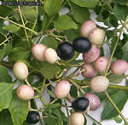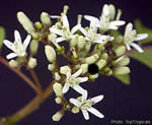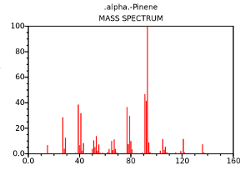Curry Leaves Murraya koenigii



About curry leaves: wikipedia.org
Essential oil
Several investigators have examined the composition of
the curry leaf's essential oil. Composition varies substantially
from location to location. This chemical diversity is very well
demonstrated in Chemical diversity in curry leaf (Murraya
koenigii) essential oils (Rao, et. al 2011). This study
identified ninety different components. Below is a truncated
table of results from this publication. The table includes only
the compounds that had maximum levels above 2%. The ten
locations are various locations within India.
| Location # | 1 | 2 | 3 | 4 | 5 | 6 | 7 | 8 | 9 | 10 | Range |
| Monoterpenes | (wild) |
||||||||||
| a-Pinene | 12.6 | 14.2 | 35.7 | 13.5 | 6.2 | 13.5 | 3.8 | 14.9 | 13.6 | 55.7 | 3.8 - 55.7 |
| b-Pinene | 1.7 | 2.0 | 6.0 | 2.0 | 0.1 | 0.2 | 0.1 | 2.3 | 2.4 | 10.6 | 0.1 - 10.6 |
| Myrcene | 2.3 | 2.7 | 1.6 | 1.7 | 0.8 | 1.3 | 0.6 | 1.8 | 1.6 | 0.6 | 0.6 - 2.7 |
| a-Phellandrene | 6.8 | 5.6 | 0.9 | 2.8 | 0.4 | 0.4 | 0.4 | 4.1 | 3.0 | - | ND - 6.8 |
| p-Cymene | 0.1 | 0.7 | 1.7 | 0.8 | 0.3 | 2.2 | 0.6 | 0.9 | 0.9 | 0.3 | 0.1 - 2.2 |
| Limonene | 6.1 | 3.7 | 2.0 | 1.8 | 1.6 | 4.8 | 1.5 | 5.1 | 3.3 | 0.8 | 0.8 - 6.1 |
| b-Phellandrene | 50.2 | 47.7 | 27.1 | 30.2 | 7.0 | 14.7 | 7.3 | 41.0 | 36.0 | 5.3 | 5.3 - 50.2 |
| (Z)-b-Ocimene | 0.2 | 1.7 | 0.2 | 2.1 | 0.3 | - | 0.3 | 0.2 | 0.1 | T | ND - 2.1 |
| (E)-b-Ocimene | 2.8 | 3.5 | 4.5 | 4.1 | 3.7 | 0.6 | 2.5 | 6.3 | 3.2 | 0.5 | 0.5 - 6.3 |
| Oxygenated monoterpenes | |||||||||||
| Linalool | 0.3 | 0.6 | 0.6 | 0.8 | 1.5 | 4.2 | 1.6 | 0.4 | 0.6 | 0.1 | 0.1 - 4.2 |
| Lavandulol | T | 0.2 | 1.5 | 0.3 | 0.4 | 8.9 | 0.7 | 0.3 | 0.3 | T | <0.1 - 8.9 |
| Geraniol | T | T | 0.1 | 11.4 | 0.5 | 0.1 | T | 0.2 | 0.1 | 0.1 | <0.1 - 11.4 |
| Geranyl acetate | T | T | 0.1 | 2.4 | T | 0.2 | T | - | - | T | ND - 2.4 |
| Sesquiterpenes | |||||||||||
| b-Elemene | T | 0.1 | 0.3 | 0.3 | 2.7 | 1.6 | 1.2 | 0.3 | 0.1 | 0.1 | 0.1 - 2.7 |
| (E)-Caryophyllene | 11.2 | 8.7 | 3.2 | 12.8 | 31.5 | 4.1 | 26.5 | 7.8 | 13.7 | 10.4 | 3.2 - 31.5 |
| a-Humulene | 1.9 | 1.6 | 0.7 | 0.7 | 6.5 | 1.5 | 5.9 | 1.7 | 3.0 | 2.2 | 0.7 - 6.5 |
| cis-b-Guaiene | 0.1 | 0.5 | 0.6 | 0.9 | 4.8 | 1.6 | 5.8 | 0.7 | 1.5 | 0.2 | 0.1 - 5.8 |
| a-Selinene | 0.5 | 1.1 | 1.0 | 2.0 | 9.5 | 2.5 | 10.4 | 1.5 | 3.2 | 0.1 | 0.1 - 10.4 |
| Oxygenated sesquiterpenes | |||||||||||
| Spathulenol | T | 0.1 | 0.1 | T | 0.6 | 0.4 | 1.9 | 0.2 | 0.7 | 0.3 | <0.1 - 1.9 |
| Caryophyllene oxide | T | 0.3 | 0.6 | 0.9 | 1.5 | 6.2 | 1.8 | 0.8 | 0.8 | 0.8 | <0.1 - 6.2 |
| 1,10-di-epi-Cubenola | - | 0.1 | 0.2 | 0.1 | 1.5 | 1.0 | 2.4 | 0.2 | 0.6 | 0.1 | ND - 2.4 |
| Selina-11-en-4a-ol | - | 0.2 | 0.4 | 0.3 | 4.0 | 4.0 | 6.3 | 0.8 | 2.0 | 0.4 | ND - 6.3 |
Rao's investigation shows that pinene levels are significantly higher in wild curry leaves than in domestic leaves. Perhaps cultivators are selecting towards more flavorful chemical variants... a matter of taste. For certain, with this chemical diversity, an individual raised in any given location would find that; nowhere else was the rasam quite like mom's
References
Fruit, flower, leaves photo credit to http://toptropicals.com
and
http://www.besgroup.org/2012/05/22/asian-koel-takes-murraya-koenigii-fruits
Choudhury, R. P., & Garg, A. N. (2007). Variation in
essential, trace and toxic elemental contents in Murraya
koenigii – a spice and medicinal herb from different Indian
states. Food Chemistry, 104, 1454–1463.
Chowdhury, A. R.
(2000). Essential oil from the leaves of Murraya koenigii
(Linn.) Spreng. Journal of Medicinal and Aromatic Plant
Sciences, 22, 643–645.
Chowdhury, J. U., Bhuiyan, M. N.
I., & Yusuf, N. (2008). Chemical composition of the leaf
essential oils of Murraya koenigii (L.) Spreng. and Murraya
paniculata (L.) Jack. Bangladesh Journal of Pharmacology, 3,
59–63.
Hiremath, S. H., Madelgeri, B. B., & Masarkar,
P. B. (1996). Essential oil constituents of wild curry leaf
(Murraya koenigii Spreng.). Indian Perfumer, 40, 110–112.
Li, Q., Zhu, L. F., But, P. P. H., Kong, Y. C., Chang, H. T.,
& Waterman, P. G. (1988). Monoterpene and sesquiterpene rich
oils from the leaves of Murraya species: Chemotaxonomic
significance. Biochemical Systematics and Ecology, 16, 491–494.
MacLeod, A. J., & Pieris, N. M. (1982). Analysis of the
volatile essential oils of Murraya koenigii and Pandanus
latifolius. Phytochemistry, 21, 1653–1657.
Mallavarapu, G.
R., Rao, L., & Ramesh, S. (2000). Volatile constituents of
the leaf and fruit oils of Murraya koenigii Spreng. Journal of
Essential Oil Research, 12, 766–768.
Onayade, O. A., &
Adebajo, A. C. (2000). Composition of the oil of Murraya
koenigii growing in Nigeria. Journal of Herbs Spices and
Medicinal Plants, 7, 59–66.
Raina, V. K., Lal, R. K.,
Tripathi, S., Khan, M., Syamasundar, K. V., & Srivastava, S.
K. (2002). Essential oil composition of genetically diverse
stocks of Murraya koenigii. Flavour and Fragrance Journal, 17,
144–146.
Rana, V. S., Juyal, J. P., Rashmi & Blazquez,
M. A. (2004). Chemical constituents of the volatile oil of
Murraya koenigii leaves. International Journal of Aromatherapy,
14, 23–25.
Rao, B.R. Rajeswara, D.K. Rajput, G.R.
Mallavarapu (2011). Chemical diversity in curry leaf (Murraya
koenigii) essential oils. Food Chemistry 126 (2011) 989–994.
Walde, S. G., Jyothirmayi, T., Prabhakara Rao, P. G.,
Shivaswamy, R., & Srinivas, P. (2005). Flavour volatiles of
leaves, fruits and seed cotyledons of Murraya koenigii. Flavour
and Fragrance Journal, 20, 169–172.
Walde, S. G.,
Jyothirmayi, T., Prabhakara Rao, P. G., & Srinivas, P.
(2006). Flavour volatiles of flowers and stalks of Murraya
koenigii L. Flavour and Fragrance Journal, 21, 581–584.
Wong, K. C., & Chee, S. G. (1996). Volatile constituents of
Murraya koenigii Spreng. flowers. Journal of Essential Oil
Research, 8, 545–547.
Wong, K. C., & Tie, D. Y.
(1993). The essential oil of the leaves of Murraya koenigii
Spreng. Journal of Essential Oil Research, 5, 371–374.
